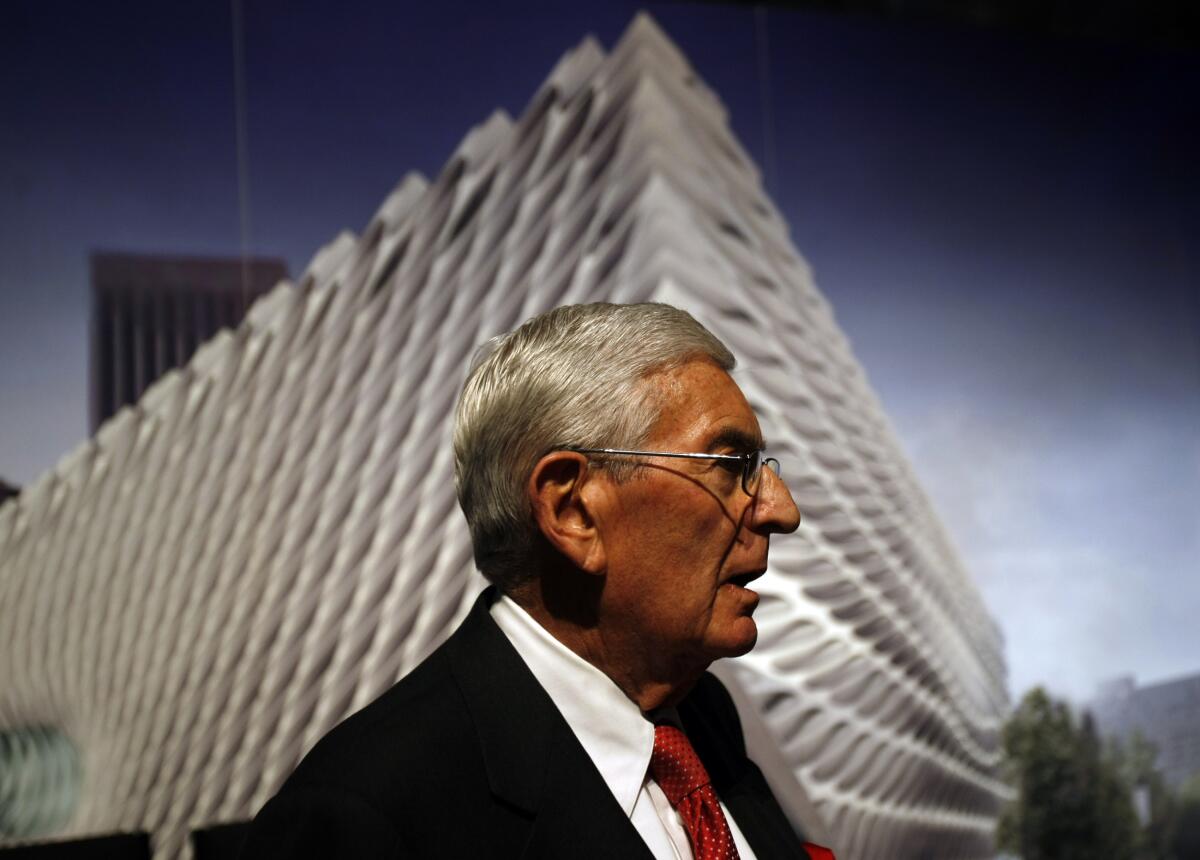Op-Ed: After Eli Broad, how will we remake Los Angeles?

Emperor Napoleon III directed his prefect of the department of Seine, Georges-Eugène Haussmann, to remake Paris. Between 1853 and 1870, the emperor’s bureaucrat drove iconic boulevards through warrens of medieval lanes and byways. Paris was made into our image of it: Belle Époque nostalgia.
Robert Moses, equally imperiously between 1924 and 1966, punched multilane highways through New York’s Black and brown neighborhoods and into the suburban countryside. Moses helped to cement an image of midcentury New York as the capital of American business and finance, deadening (for urban critic Jane Jacobs) much of what made the city livable.
Eli Broad, who died April 30 at 87, sought to remake the image of Los Angeles with the single-mindedness of a Haussmann or a Moses, commissioning or otherwise conjuring a series of grand buildings, beginning with the Museum of Contemporary Art at the apex of Bunker Hill. Walt Disney Concert Hall, frisky and buoyant and entirely in the spirit of Los Angeles, is the most successful. But often the buildings he fretted over reflect Broad’s image more than the city’s, particularly the cheerless museum he named for himself. It’s as if the Broad, now his cenotaph, had subsumed the man.
Broad’s most ambitious remaking of the city’s skyline is the Grand Avenue project, intended, he once said, to turn the blocks from the Broad to the Cathedral of Our Lady of the Angels into the Champs-Élysées of Los Angeles. The project’s pivot is the Grand — 176,000 square feet of restaurant and retail space, a hotel and apartments (some of them affordable-rate units) designed by Frank Gehry and facing Gehry-designed Disney Hall. Construction of the billion-dollar high-rise towers topped out only a few weeks before Broad’s death. Finding luxury brands to fill the retail space is proving to be hard.
Grand Avenue is the top stroke of a T; the descending stroke is Grand Park — 16 acres of open space that slopes down from the foot of the Music Center, past government buildings, to the steps of City Hall. Thanks to the efforts of the city and the county, the park is already becoming a site of communal celebration. Broad took to calling it “our Central Park.” It isn’t. Just as Grand Avenue won’t be “our Champs-Élysées.” Those places are thickly layered with the memories, daydreams and historical associations that endowed them with a sense of place. Grand Avenue and Grand Park — so new — are waiting for the accretion of Angeleno experiences to gain their own sense of place. When they do — if they do — the avenue and the park shouldn’t be understood as simulations of Paris or New York; they should be felt as ours.
To better serve its future sense of place, Grand Avenue may require less architecture and more humanity. Proposals for landscaped plazas, outdoor performance spaces and making part of Grand Avenue a pedestrian mall point in the right direction.
A first look at Frank Gehry’s Colburn School concert halls and plaza, which are key to making Grand Avenue in DTLA the nation’s premier arts district.
Broad’s ambitions ought to prod Angelenos to consider what they think should be central to their city. Emperors, bureaucrats and billionaires mold cities to their desires, but so could humbler aspirations. Broad was a notoriously difficult partner in the art of city making, fantastically generous where it suited him but confusing the common good for what he wanted. Former Los Angeles Times architecture critic Christopher Hawthorne complained in 2010 that Broad had failed to use the Grand Avenue project to engage in a dialogue with Angelenos about the urban character of their downtown. Broad’s passing allows for a recalibration.
Until the 1980s, the image of downtown was dominated by the aloof, white tower of City Hall, thrusting (by law) above the low-rise commercial buildings gathered loosely on hills. In today’s iconic Los Angeles cityscape, those hills disappear, the towers of downtown are silhouetted against the San Gabriel Mountains, and City Hall is barely visible. The Grand Avenue project isn’t even in the picture.
Critics, politicians and billionaires like Broad have lamented that Los Angeles — multipolar, horizontal and mostly human-scale — needs to straighten up, stand taller and be centered. Grand Avenue’s collection of emphatic buildings — many stamped with the stubborn personalities of Broad, the visionary, and Gehry, the designer — could accelerate all that. But Los Angeles, post-COVID-19, will be shaped by forces neither Broad nor his famous architect anticipated.
The granite-faced office towers that took possession of redeveloped Bunker Hill in the 1980s — writer Mike Davis’ sinister City of Quartz — have been partially empty for the last year. Decentered and distributed employment may keep them that way. Big plans for the Colburn School adjacent to Disney Hall are already faltering because of the extraordinary expense of sumptuous and idiosyncratic architecture. Grand Avenue could be a memorial to an urbanism of big gestures that is passing into history.
The postmortem on Broad’s presence in Los Angeles has focused on what he made of the image of the city and not on what Angelenos felt about it. Maybe we felt nothing. We need to start, if the future Los Angeles is to mean anything to us.
D. J. Waldie is the author, most recently, of “Becoming Los Angeles: Myth, Memory, and A Sense of Place.”
More to Read
A cure for the common opinion
Get thought-provoking perspectives with our weekly newsletter.
You may occasionally receive promotional content from the Los Angeles Times.










